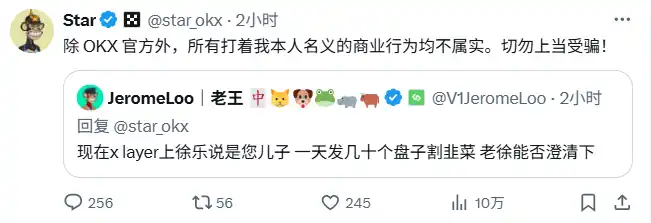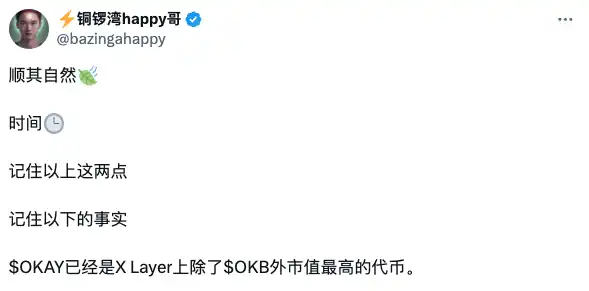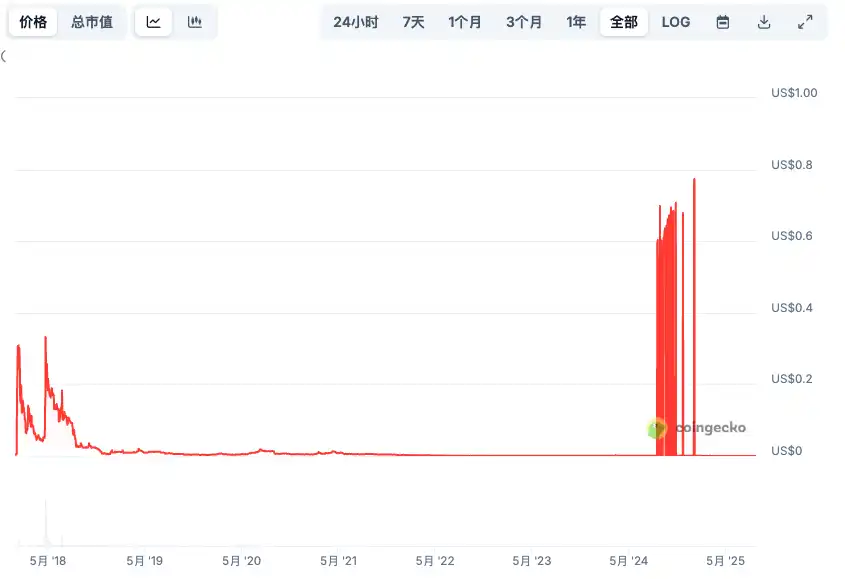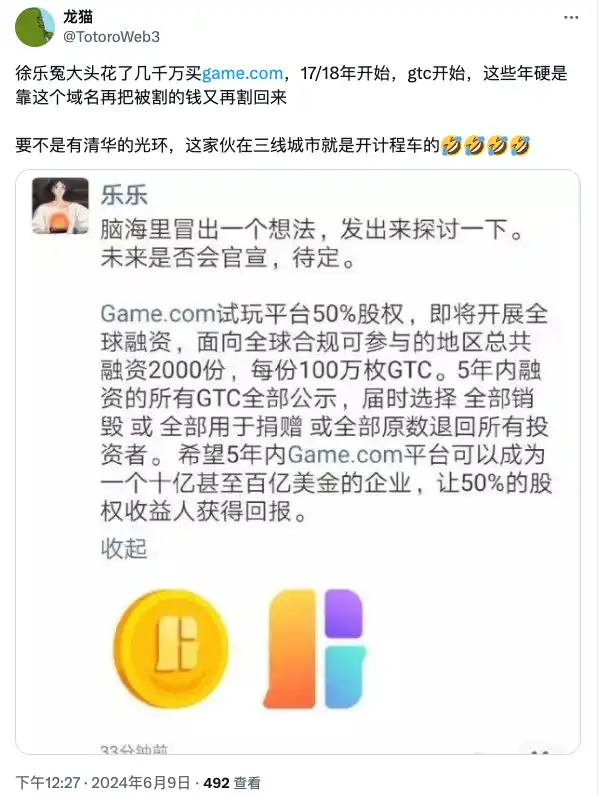The cryptocurrency world is never short of new stories, but the hottest name recently is undoubtedly Xu Le.
From OKB's fivefold surge to over $250 in a week to the sudden popularity of the meme market on X Layer, the recent buzz in the Chinese-speaking cryptocurrency community has almost entirely been dominated by the OKX ecosystem.
At this juncture, OKX founder Xu Mingxing had to post late at night to refute two rumors: first, he reminded investors not to chase after OKB's price fluctuations, and second, he shared a post questioning whether "Xu Le is Xu Mingxing's son," clarifying, "I have no business dealings with Xu Le."

Those in the cryptocurrency space who do not understand memes and do not follow "shitcoins" couldn't help but question—who is Xu Le? Do Xu Le and Xu Mingxing actually know each other?
"He deleted me from WeChat," Xu Le said.
A Tsinghua University Dropout and Serial Entrepreneur
On the other side of the rumors, Xu Le was not idle. He posted several tweets, launching multiple new projects: Okay, created by a user, and ODOG, which he built himself, with various projects flooding the screen, hundreds of times for OKAY and dozens of times for ODOG. For a time, X Layer seemed to become his exclusive platform for promoting projects; whatever he promoted, the market would take off.

From Xu Mingxing's refutation, it appears that Xu Le's name was not originally part of the fervor surrounding X Layer.
However, Xu Le seized the opportunity to promote a platform called okaydotfun, as OKX aimed to push X Layer. Unlike Pumpfun, it attempts to incorporate distribution and buyback mechanisms to create an internal flywheel. But controversy soon followed.
Okaydotfun seems more like Xu Le's personal experiment in promoting projects, and whether the hype can be sustained and whether the platform can escape the fate of being just another traffic-driven project remains a question mark. Regardless of the answer, both X Layer and Xu Le have been thrust into the spotlight. The outside world was once confused about whether Xu Le had any ties to OKX.
Digging into Xu Le's background, he was admitted to Tsinghua University at the age of 16. At 18, he dropped out to start a business in Beijing but was cheated out of 200,000 by a partner; at 19, he borrowed money to start a payment company, and within seven days, someone invited him to collaborate on Alipay; at 21, inspired by a television program, he started another business and even bought a house in Beijing outright. Xu Le's trajectory has been tumultuous.
In 2017, he spent 100 million yuan to buy the domain Game.com and launched a gaming platform called "Lele." This also marked the beginning of his foray into cryptocurrency speculation. Based on Game.com, he launched the GTC project in 2018, which saw GTC coins soar from 0.0477 USDT to about $0.4 in just three days, a nearly tenfold increase. However, the good times didn't last long, as this astonishing surge was soon followed by a crash—prices fell from the peak to about 0.13 USDT, a drop of 72%.

GTC Price Trend
The rollercoaster ride of skyrocketing and plummeting prices sparked significant controversy. Critics labeled it a typical "shitcoin," having memes but lacking substantive value, questioning its essence as capital speculation rather than being driven by real applications. All of this caused Xu Le to quickly fall from being a "pioneer in mobile gaming" into controversy. Some referred to him as a "harvester," but he later responded that he did not make money and even lost all his investment. The story of GTC became the most controversial chapter in his entrepreneurial history, tarnishing his identity in the cryptocurrency space.

Community Evaluation of Xu Le's GTC
When discussing his attitude towards Memecoins, Xu Le told Rhythm BlockBeats, "I treat them as game coins. I am definitely a super player in the circle; there are not many people like me who can spend millions or even tens of millions of dollars on a coin. I can make tens of millions of dollars in a day and then lose it all in a few days. I made over $20 million on Trump coin, and I lost a few million on the Argentine president's coin. This is all human nature; human nature is greedy."
He believes that the current meme culture is essentially a speculative game, where income and losses are just wins and losses in the game. When asked about the hundreds of tokens he participated in and shared on Twitter, he said, "I spent money, so I certainly have the right to express my preferences."
Okaydotfun was able to launch so quickly because he had already created many fun platforms. From Solana (Gamecom, HotFun) to BSC (Jagger.fun) and now X Layer (Okay, OKO), he has almost gone through all public chains.
The ability of this type of product to make money is one aspect; the market's threshold for meme-driven speculation has also lowered significantly.
Meme Launchpads Have Brought the Threshold for Speculation to Nearly Zero
A few years ago, GTC skyrocketed tenfold in a few days and then plummeted, which was recognized as a "harvesting" operation. Today, this "quick in and out" play has become commonplace in the market; a meme coin can surge and plummet within a minute, and no one would say it's harvesting; they would say, "I just bet wrong this time."
Since its inception last year, Pump.fun has created over 12.4 million tokens, with more than 80% of the tokens issued by Pump.fun ultimately dropping below their original highs by over 90%. Less than 10% of traders have made over $1,000, and over 70% of traders are at a loss. This means that even though the vast majority of Memecoins in the market quickly explode and then quickly collapse, there are still people continuously participating, and this phenomenon has been regarded as the norm in the industry.

The graduation rate of Pumpfun shows a clear downward trend, while the probability of tokens going to zero shows a clear upward trend.
This seems to give Xu Le a new opportunity; a few years ago, GTC was widely criticized, but in the current wave of X Layer, players who have lost money may not say Xu Le is harvesting, but will continue to look for the next opportunity.
We had a conversation with Xu Le on topics of interest to the market. Below are excerpts from the interview.
About the Rumors
Rhythm BlockBeats: What is your relationship with OKX?
Xu Le: There is no so-called special relationship. Our positioning is an open ecosystem that relies on products and users to speak, not backdoor dealings. What we value more is the user base and usage threshold of OKX Wallet and OK Pay, as well as their recent improvements in wallet, group chat components, red envelopes, and other capabilities. These are the practical foundations for our choice of X Layer, not resource exchanges through backdoor dealings.
Rhythm BlockBeats: Have you had any interactions with Xu Mingxing from OKX?
Xu Le: We have met and were WeChat friends. However, due to conflicts with the OKX review team during the delisting of the GTC project, I was directly delisted, and in the end, Xu Mingxing deleted me. In hindsight, I think I was too impulsive at the time; if I had shown a bit more respect and communication, perhaps the outcome would have been different.
Rhythm BlockBeats: The market believes OKX is preparing for an IPO; will meme coins have a negative impact on their compliance? Could it become a risk?
Xu Le: This is OKX's consideration, not ours. The X Layer mainnet is open, and no chain will reject a platform that can bring users and transactions. We do not rely on OKX's endorsement; we survive on our own.
Rhythm BlockBeats: Some say you are the king of promotions; what do you think?
Xu Le: I don't think of myself as the king of promotions. I am a "super player," buying and playing every day. I made tens of millions of dollars on Trump coin and have lost tens of millions on other coins. So, I am both a co-founder of the platform and a super player—this is not contradictory. My style is different from Pumpfun founder Alon; he chooses silence, while I choose to step into the spotlight because at this point in time, someone needs to speak up and drive things forward.
Rhythm BlockBeats: Since you are both the platform provider and personally trading, could there be a conflict of interest?
Xu Le: Some say I am both the referee and the athlete, but that doesn't matter to me. My goal is clear—to make X Layer the first choice for everyone when they want to issue meme coins, and to make our platform the first choice. As long as we achieve this, how the outside world defines it doesn't matter.
Rhythm BlockBeats: How is your platform funded? Are you using your own money?
Xu Le: It is entirely self-funded, with no external financing. The entrepreneurial process is very painful, often requiring the sale of assets to maintain the team. No one can understand that kind of torment.
Rhythm BlockBeats: Do you hope to receive support from OKX in the future?
Xu Le: Hope is hope, but I will never place my hopes on others; I only rely on my own efforts. As long as we perfect our products and community, cooperation with trading platforms and wallets will come naturally.
About the Product
Rhythm BlockBeats: You have made many attempts on Solana; why suddenly go all-in on X Layer?
Xu Le: We spent 15 months honing our skills on Solana, failing countless times but gaining experience. After X Layer emerged, we judged that this was a new traffic entry point. The user base of OKX Wallet is the biggest advantage. In comparison, PotatoSwap is basically neglected, and DYOR's UI experience is also poor.
The timing is crucial; we judged that "speed is an advantage," so we quickly went all-in within 100 hours of launch, transferring all the "failure experiences" from Solana to reuse.
Rhythm BlockBeats: How is your launch platform different from traditional token issuance models?
Xu Le: In the past, it was "someone wants to issue a token → comes to the platform → uses tools to issue," but there aren't that many people who want to issue tokens. We changed the logic to "everyone can create a game": you can tokenize hot events, certain accounts, or specific works. Everyone acts like a scout; once they enter the system, they can create their own meme world.
Rhythm BlockBeats: You just mentioned "everyone can issue tokens." Could this lead to an excess of junk projects?
Xu Le: There will definitely be junk, but the platform mechanism ensures that traffic, transaction fees, and buybacks will only concentrate on popular memes that are recognized by the community. Just like TikTok, where a large number of videos are uploaded every day, only a few go viral in the end. The tools must guarantee "survival of the fittest," rather than "forced selection."
Rhythm BlockBeats: You mentioned OKO dot Fun; what is its relationship with OKAY dot Fun?
Xu Le: OKO dot Fun is a more innovative token distribution model that completely overturns the traditional Bonding Curve. For example, setting a goal to distribute 80% of the tokens within 4 hours, with allocations made every second based on real-time funding ratios. This way, there is no "one-time" early bird advantage; competition must continue every second.
Question: Every chain's meme has a lifecycle. How long can the hype around X Layer last?
Xu Le: There will definitely be fluctuations in the hype, but memes themselves are a cultural phenomenon and won't disappear overnight. Today, people see it as a short-term frenzy, but it's actually similar to when Bitcoin first emerged; no one understood its cultural power. What we care more about is whether we can convert this hype into retention, turning users from "jumping in for a wave" to "coming back to play regularly." If it relies solely on a market surge, it will cool down in three days; but if we can improve the mechanisms, gameplay, and community, the hype will continuously refresh itself.
Rhythm BlockBeats: Many people believe you harvested a lot of retail investors with the GTC project. How do you view this issue?
Xu Le: For me personally, it was a huge blow. At that time, the market cap surged to $1.1 billion in three days, and I was hailed as a "god," but three days later it crashed, and I immediately became a "scammer." I also lost all my invested funds. This shift is very brutal. But in the larger context, the entire market was crashing at that time; it was the trend of 2018, with Ethereum dropping from $1,500 to $80. Individual power cannot withstand the trend.
Conclusion
At least from the public responses, Xu Le does not have a direct commercial tie with OKX.
He chose to build okaydotfun on X Layer and quickly amplified his influence with a "promotional" personal style, which coincided with OKX's strategic rhythm, creating an unexpected chemical reaction. He became the most influential figure in the narrative surrounding OKB's burn.
Of course, in an ecosystem of a trading platform that is seeking compliance, the long-term existence of the meme craze is inherently filled with uncertainty. What is certain is that X Layer provides a new traffic entry point, and Xu Le has found the best timing to make his move.
The above content is for reference only and should not be considered investment advice.
免责声明:本文章仅代表作者个人观点,不代表本平台的立场和观点。本文章仅供信息分享,不构成对任何人的任何投资建议。用户与作者之间的任何争议,与本平台无关。如网页中刊载的文章或图片涉及侵权,请提供相关的权利证明和身份证明发送邮件到support@aicoin.com,本平台相关工作人员将会进行核查。




